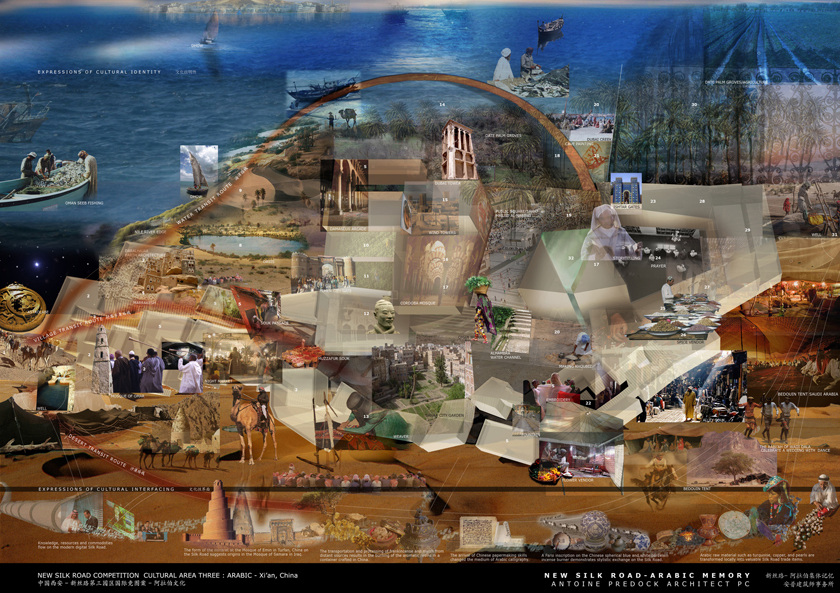|
|
The New Silk Road
Arabic Cultural Area
Xi'an, China
A
liquid morning rose; from the sky, fresh as a rose, a quivering light
fell, endowing each house, each tree with a palpable shape and a magic
newness. The earth must have risen in just such a light the morning the
world was born.
-Albert Camus
NEW SILK ROAD: ARABIC MEMORY
Secluded behind a massive earth
wall the New Silk Road: Arabic Memory comes into view through a landscape
of desert, oasis and shorelines – artifacts of ancient
Mesopotamia. A procession through an expanse of sand dunes and
desert transitions the visitor from urban Xi’an into Arabic time
travel. The passage encourages the visitor to visualize the infinite expanse
of Arabian deserts and reflect on the landscape which helped to form Arabic
and pre-Arabic cultures.
The ambitions of the New Silk Road Park competition demand innovative
spatial and organizational responses to bring the Arabic world into view.
Our starting point is the desire to “provide an experience echoing
pf the moment of transit, and convey the rich and subtle nuances of the
timeless landscapes and the nomadic cultures irrigated by the famous trail”,
as stated in the Project Brief. Our spatial sequences present tableaus
for visitors, artists, and scholars constructed of multiple vantage points
expressive of the plurality of Arabic society similar to the kaleidoscopic
vision of Lawrence Durrell’s Alexandria Quartet. The two –dimensional
physicality of Islamic calligraphy extrapolates to a three dimensional
kinesthetic experience.
The New Silk Road: Arabic Memory is presented as a cinematographic compression
of time and space wherein unfolds a panorama of stories. Arabic culture
shadows appear episodically within the cinematic digital score, imbuing
the project with a sense of infinite memory. The visitor’s experience
is informally guided along three north – south routes; traversing
the Desert Transit Route, Village Transit Route, and Sea Transit Route
with the aid of digital media visitors accumulate experience. The routes
are spatial episodes, accruing a continually branching pan-Arabic perspective.
A digital overlay throughout the site interweaves pan –Arabic subtexts
amplified in the Silk Web Cafés – media enhanced Archive
and Exhibit realms.
They could see the endless flat desert beyond, broken
here and there by sharp crests of rock that rose above the surface like
dorsal dins of so many monstrous fish, all moving in the same direction.
-Paul Bowles
The modern Silk Road is a digital version of the original; a network connecting
global nodes with wire, cable, satellite and air travel. Information central
to the contemporary global economy, collapses space and time in the quest
for speed and efficiency, enforcing the remoteness of physical commodity.
As one of the primary sources of oil, the vast wealth of the Arab nations
has created consumers of the modern equivalents of the luxury goods passed
through the ancient conduit between China and Europe. The modern Silk
Road feeds focal Arabic cities such as Dubai, Jeddah, Amman, Cairo, Kuwait
City and Doha with travel, banking and digital communication.
The New Silk Road: Arabic Memory joins the tradition of Arabian calligraphic
intent with its origins in symbolic visual reference and, multiplicity
of meaning and interpretation. The New Silk Road: Arabic Memory establishes
a complete presence on the site buy physically projecting Arabic daily
existence and celebrating the historic connection between the Arab world
and the Silk Road and the less tangible connections the Arab world makes
through the modern Silk Road, inform a journey through a physical manifestation
of Arabic space. Purposeful in its intent to engage community, the New
Silk Road: Arabic Memory is an approachable celebratory community center;
a living tapestry that is woven and read, felt and lived, as it travels
back in time, spirals and unfolds toward contemporary Arabia and beyond
to the future.
|
